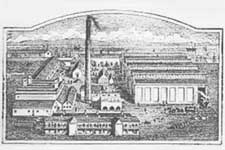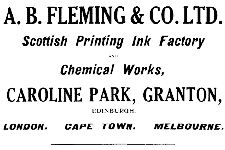A B Fleming & Company
A B Fleming & Company operated at Granton from 1872 to 1983. Their premises were located to the south of West Shore Road, immediately north of Granton Gas Works (opened in 1902).
The company made printing ink of various types, and was well located as Edinburgh was for many years a centre of the printing industry. However their business developed to the extent that they had customers in may parts of the world.
Although their factory was purpose-built, they took over an existing and historic building, Caroline Park, as their office.
Another essential for printing was paper, for which one of the raw materials was esparto grass, imported in large quantities through Granton Harbour.
Where was it?
The company’s premises are marked as ‘Scottish Printing Ink Factory and Chemical Works’. The vacant site immediately to the south would used for Granton Gas Works within a few years of the date of this map.
Caroline Park is a little further east:
Company history
A B Fleming & Co was established in 1852. The firm was a partnership between Alexander Bonar Fleming (the 24 year old son of a banker dissatisfied with his position as a junior clerk in an insurance office) and a Dr Parnell who knew how to make printing ink. The initial capital was £1,500. They set up a small works at Salamander Street, Leith. After a difficult initial period, orders from the ‘Times’ in London and the ‘Melbourne Argus’ set them on the road to success.
The Salamander Street works soon became too small, and in 1870 a large area of ground was leased from the Duke of Buccleuch and new premises were built at Caroline Park, Granton. The mansion house of Caroline Park was purchased from the Duke of Buccleuch and was used as the office.
In 1880 when the undertaking became a limited company it was a substantial thriving and progressive concern. The company established a branch factory in Dundee, producing lubricating oils and greases. These were used in the jute trade in Dundee and Calcutta. Restriction on exports during World War I struck a blow at the Indian trade which was captured by Burma and America and was never recovered. The premises at Dundee were disposed of.
Between the wars Caroline Park works were almost entirely rebuilt. Practically all the colours used in Fleming’s inks were produced at Caroline Park which was unusual in the industry. Fleming’s colours were used in Norway, Sweden, Denmark, France, Spain, Portugal, Egypt, India, Japan, China, Australia, New Zealand, South Africa, Argentina, Brazil and Canada.
In 1953, the company expanded by acquiring a new factory at Corstorphine, adjacent to the Maybury junction, on the main Glasgow Road (the A8). The building was of modern single-storey construction with a floor area of 40,000 square feet including office and staff accommodation. The production of high grade letterpress and lithographic inks at the Granton factory was transferred in stages. The transfer provided scope for further development at Granton where the main research labs were located. In 1966, the company moved its headquarters to Corstorphine following extensions to their premises there.
A major change came in 1971, when Croda International, the chemicals group, announced a bid for ABF (Holdings) as the company was now called. At the time, the company was still based in Edinburgh but also had factories London, Middlesex, Manchester, Kent, Winsford, Dublin, Cape Town, Johannesburg, Durban, Port Elizabeth and Salisbury, Rhodesia (now Zimbabwe). They employed about 900 people. The ABF name disappeared after the company was bought over by Croda. The Granton plant closed in 1983. The company became part of the Fishburn Printing ink Company, based at Watford, in 1985. By 1986 the only remaining plant in Edinburgh was at Maybury. It was closed on 27 March 1986 with the loss of about forty jobs.
Printing processes
A number of different processes are used for printing, and each needs ink produced specifically for it to get the best results. The main processes are:
Letterpress
This uses raised type. The ink is applied to the raised surface of the type only, and is then pressed onto the paper.
Lithography
This uses a flat surface as the printing plate. An oily or waxy chemical is applied to the areas that are not to be printed, and the ink is applied to the whole surface but adheres only to the parts that have not had the chemical applied to them. The ink is then transferred onto the paper.
Gravure
The text to be printed is cut into a flat surface, either mechanically or (for example) by photo-etching. Ink is applied to the whole surface but scraped off with a blade, remaining only in the parts that have been cut.
Offset
This method uses an intermediate ‘blanket’ to which the ink is transferred from the original before being applied to the paper. This makes it easier to print on paper that is not flat, for example in a rotary press where the paper is carried through the press on large rollers.
Products
A B Fleming made inks suitable for a wide variety of processes, and in a range of qualities (and therefore price).
Fleming’s rosin inks refined at Granton from American rosin and known as Granton Oils earned a reputation for quality which was recognized in home and foreign markets. Vegetable blacks used in ink manufacture were also produced in fine grades. The rise of American competition found the firm adopting mineral for rosin oil and carbon black for vegetable black.
Also produced were lubricating oils of various types.
A team of chemists and assistants were employed in the laboratories at Caroline Park developing new products and improving the existing products. These included printing inks of all types, for letterpress, lithographic, aniline and gravure printing on paper and films and for newspaper printing and inks for high speed rotary printing from rubber plates. Also produced were waxed wrapped inks and special concentrated inks for 3 and 4 colour letterpress, offset printing etc.
Sources and further information
There is material on file at the Edinburgh Room, Central Library, George IV Bridge, Edinburgh – ref Ref YTP949 (class) C57907 (Accession).
See also the sources noted in the page about Caroline Park for information about that building, used as Fleming’s offices.

